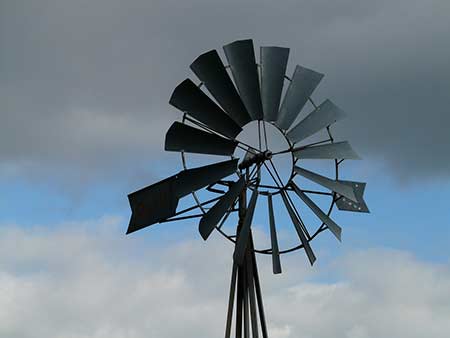
Curiosity › Science › Physics › Why most wind turbines have three blades while one is the most efficient design?
Tagged: Aerodynamics, Wind Turbines
In olden days, most of the wind turbines had more than three or even ten blades.
Like this one:

I recently found that one-bladed wind turbines are the most efficient design than a two-bladed. Why is that most wind turbines now have three blades? Are there any serious considerations for such less efficient design?
You are correct! One-bladed turbines are the most efficient one.
One-bladed wind turbines
These type of wind-turbines have high rotational speeds and hence, the efficiency is higher when compared to the other configurations. However, due to this high rotational speed, the hub of the wind turbine is subjected structural stress. To avoid this, designers add a counter-weight to balance this. Also, the hub would need additional shock absorbers to avoid any turbulent forces acting on the shaft. Then again, this increases the cost.
Two-bladed wind turbines
These balances the cost that is spent on the one-bladed design’s weight. With two blades, the wake interference is very less too (compared to three). This was once a conventional design. But as two blades rotate, the whole rotor disk experiences an imbalanced air flow on the upper part and the lower part (laminar flow, with earth being the boundary). This twists the shaft horizontally, and to counter this, the hub should be teetering one. Of course, this adds up the cost too.
Three-bladed wind turbines
Add a third blade, and you could eliminate the teetering hub. This makes it easy for the rotor disk to be balanced. In this case, the efficiency is less, but a tradeoff is made for other factors. For example, in the above two design configurations, the hub would need a complex gearbox due to the requirement of a higher gear ratio. With this three-bladed design, the cost of such complexity is eliminated too. So this is considered as an optimal configuration.
More blades
For larger wind turbines, if you add more blades the efficiency will drop, as the wake of one blade will affect the flow vector of another blade in an undesirable way. But in smaller windmills like the one used to draw water by running pumps, you would need more blades as it gives a high torque.
I hope this answers your question. However, I would wait for a professional wind turbine expert to weigh in here.
This is very interesting. Thank you for the detailed answer Karthik.
But in smaller windmills like the one used to draw water by running pumps, you would need more blades as it gives a high torque.
The above statement makes sense. While considering the same case of multiple blades to a larger turbine why does it fail? What if the larger turbines used thin blades that are designed in a way not to affect the other blades? Would a five-bladed turbine be more efficient?
I had the same intuitions when I began exploring this. Fortunately, the concept of ‘continuity’ knocked my mind and I found something interesting. There is, of course, a maximum theoretical limit for the maximum efficiency of a wind turbine. Check out Betz’s Law.
No turbine can capture more than 16/27 (59.3%) of the kinetic energy in the wind.
Besides all this, there is a bigger problem when you come to larger turbines. If you add more blades, the component cost per wind turbine increases way high compared to the energy you obtain from the configurations. Also, the weight increases with each blade along with the torque. Higher torque will need stronger structural parts like more efficient gear boxes, break shoes and yawing gears. It’s quite complex though.
Adding to Karthik’s answer, aesthetic value is another reason why companies prefer three bladed turbines over two. It just looks good that way.
You must be logged in to reply to this topic. Log In

